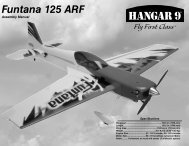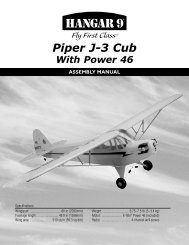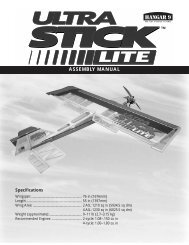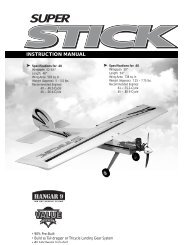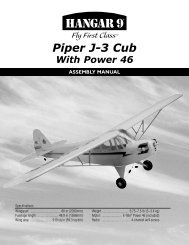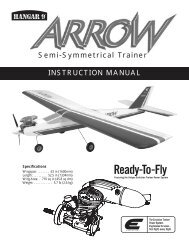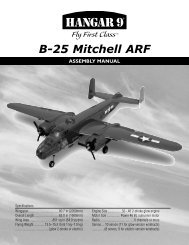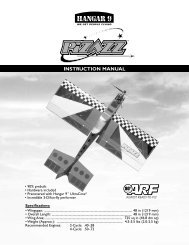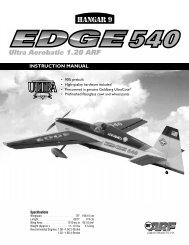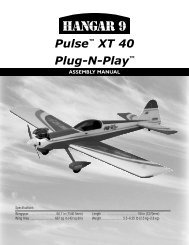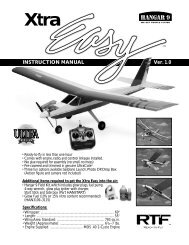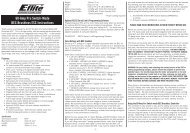1/4 Scale Cub Floats Manual - Horizon Hobby
1/4 Scale Cub Floats Manual - Horizon Hobby
1/4 Scale Cub Floats Manual - Horizon Hobby
- No tags were found...
You also want an ePaper? Increase the reach of your titles
YUMPU automatically turns print PDFs into web optimized ePapers that Google loves.
1/4-<strong>Scale</strong> <strong>Floats</strong>Assembly manualSpecificationsLength....................................................................................................................................47.625 in (1210mm)Overall Width of Float Assembly................................................................................................27.25 in (692mm)Tip of Float to the Step...............................................................................................................25.25 in (641mm)Approximate Weight of Each Float Less Rudder Servo...................................................................................30 oz<strong>Scale</strong> Struts Weight.....................................................................................................................................15.4 ozTotal Weight.......................................................................................................................................... 75 to 80 ozFor Models Weighing......................................................................................................................12.0 to 18.0 lb
Table of ContentsUsing the <strong>Manual</strong> ..................................................................2Required Tools and Adhesives ........................................................3Before Starting Assembly ............................................................3Recommended Accessories ..........................................................3FS One ..........................................................................3Warranty Period ...................................................................4Limited Warranty. ..................................................................4Damage Limits ....................................................................4Safety Precautions .................................................................4Questions, Assistance and Repairs .....................................................5Inspection or Repairs ...............................................................5Warranty Inspection and Repairs.......................................................5Non-Warranty Repairs...............................................................5Safety, Precautions and Warnings......................................................6Contents of Kit ....................................................................6Float Assembly ....................................................................7Float Installation ..................................................................15Recommended Center of Gravity (CG) .................................................172008 Official AMA National Model Aircraft Safety Code................................ 18–19Instructions for Disposal of WEEE by Users in the European Union...........................20Using the <strong>Manual</strong>This manual is divided into sections to help make assembly easier to understand, and to provide breaks between eachmajor section. In addition, check boxes have been placed next to each step to keep track of each step completed. Stepswith a single box () are performed once, while steps with two boxes ( ) indicate that the step will requirerepeating, such as for a right or left wing panel, two servos, etc. Remember to take your time and follow the directions.2
Required Tools and AdhesivesTools• Phillips screwdriver: #1• Drill bit: 5/64-inch (2mm)• <strong>Hobby</strong> knife w/ #11 blade• <strong>Hobby</strong> knife• Painter's tapeAdhesives• Silicone sealant• Medium CABefore Starting Assembly• Pin drill• Silicone sealant• Adjustable wrench• Ball driver: 1/8-inch, 3/32-inch• Plastic wrap or waxed paper• ThreadlockBefore beginning the assembly of your 25% Fiberglass <strong>Floats</strong>, remove each part from its bag for inspection. Closelyinspect each piece for damage. If you find any damaged or missing parts, contact the place of purchase.Recommended Accessories• DS821 Digital Sport Hi-Torque Servo or equivalent (JRPS821) (2)• 18-inch Servo Lead Extension (JSP98120) (2)Required when using computer radio:• 12-inch Servo Lead Extension (JRPA098)• 6-inch Y-Harness (JSP98020)Required when using non-computer radio:• 6-inch Y-Harness (JSP98020) (2)FS OneWith FS One ® you get more than photorealistic fields, gorgeous skies and realistic-looking aircraft. You get incrediblyadvanced aerodynamic modeling that simulates every possible aspect of real-world flight.The first Hangar Pack will add even more aircraft to FS One. This latest editionincludes ten new planes and helis from your favorite brands, includingHangar 9, E-flite and Align. You’ll be able to fly aircraft that are only availableon FS One such as the T-REX, Blade CX2, Blade CP Pro, Hangar 9 P-51and F-22 PTS. And as always, with the Hangar Pack, you still get all theHANS2000HANS4010same great features that you did with the original aircraft.3
Warranty PeriodExclusive Warranty- <strong>Horizon</strong> <strong>Hobby</strong>, Inc., (<strong>Horizon</strong>) warranties that the Products purchased (the "Product") will be freefrom defects in materials and workmanship at the date of purchase by the Purchaser.Limited Warranty(a) This warranty is limited to the original Purchaser ("Purchaser") and is not transferable. REPAIR OR REPLACEMENTAS PROVIDED UNDER THIS WARRANTY IS THE EXCLUSIVE REMEDY OF THE PURCHASER. This warranty covers onlythose Products purchased from an authorized <strong>Horizon</strong> dealer. Third party transactions are not covered by this warranty.Proof of purchase is required for warranty claims. Further, <strong>Horizon</strong> reserves the right to change or modify this warrantywithout notice and disclaims all other warranties, express or implied.(b) Limitations- HORIZON MAKES NO WARRANTY OR REPRESENTATION, EXPRESS OR IMPLIED, ABOUT NON-INFRINGEMENT, MERCHANTABILITY OR FITNESS FOR A PARTICULAR PURPOSE OF THE PRODUCT. THEPURCHASER ACKNOWLEDGES THAT THEY ALONE HAVE DETERMINED THAT THE PRODUCT WILL SUITABLY MEETTHE REQUIREMENTS OF THE PURCHASER’S INTENDED USE.(c) Purchaser Remedy- <strong>Horizon</strong>'s sole obligation hereunder shall be that <strong>Horizon</strong> will, at its option, (i) repair or (ii)replace, any Product determined by <strong>Horizon</strong> to be defective. In the event of a defect, these are the Purchaser's exclusiveremedies. <strong>Horizon</strong> reserves the right to inspect any and all equipment involved in a warranty claim. Repair or replacementdecisions are at the sole discretion of <strong>Horizon</strong>. This warranty does not cover cosmetic damage or damage due to acts ofGod, accident, misuse, abuse, negligence, commercial use, or modification of or to any part of the Product. This warrantydoes not cover damage due to improper installation, operation, maintenance, or attempted repair by anyone other than<strong>Horizon</strong>. Return of any goods by Purchaser must be approved in writing by <strong>Horizon</strong> before shipment.Damage LimitsHORIZON SHALL NOT BE LIABLE FOR SPECIAL, INDIRECT OR CONSEQUENTIAL DAMAGES, LOSS OF PROFITS ORPRODUCTION OR COMMERCIAL LOSS IN ANY WAY CONNECTED WITH THE PRODUCT, WHETHER SUCH CLAIMIS BASED IN CONTRACT, WARRANTY, NEGLIGENCE, OR STRICT LIABILITY. Further, in no event shall the liability of<strong>Horizon</strong> exceed the individual price of the Product on which liability is asserted. As <strong>Horizon</strong> has no control over use,setup, final assembly, modification or misuse, no liability shall be assumed nor accepted for any resulting damage orinjury. By the act of use, setup or assembly, the user accepts all resulting liability.If you as the Purchaser or user are not prepared to accept the liability associated with the use of this Product, you areadvised to return this Product immediately in new and unused condition to the place of purchase.Law: These Terms are governed by Illinois law (without regard to conflict of law principals).Safety PrecautionsThis is a sophisticated hobby Product and not a toy. It must be operated with caution and common sense and requiressome basic mechanical ability. Failure to operate this Product in a safe and responsible manner could result in injuryor damage to the Product or other property. This Product is not intended for use by children without direct adultsupervision. The Product manual contains instructions for safety, operation and maintenance. It is essential to readand follow all the instructions and warnings in the manual, prior to assembly, setup or use, in order to operate correctlyand avoid damage or injury.4
Questions, Assistance and RepairsYour local hobby store and/or place of purchase cannot provide warranty support or repair. Once assembly, setup oruse of the Product has been started, you must contact <strong>Horizon</strong> directly. This will enable <strong>Horizon</strong> to better answer yourquestions and service you in the event that you may need any assistance. For questions or assistance, please direct youremail to productsupport@horizonhobby.com, or call 877.504.0233 toll free to speak to a service technician.Inspection or RepairsIf this Product needs to be inspected or repaired, please call for a Return Merchandise Authorization (RMA). Packthe Product securely using a shipping carton. Please note that original boxes may be included, but are not designedto withstand the rigors of shipping without additional protection. Ship via a carrier that provides tracking and insurancefor lost or damaged parcels, as <strong>Horizon</strong> is not responsible for merchandise until it arrives and is acceptedat our facility. A Service Repair Request is available at www.horizonhobby.com on the “Support” tab. If you do nothave internet access, please include a letter with your complete name, street address, email address and phone numberwhere you can be reached during business days, your RMA number, a list of the included items, method of paymentfor any non-warranty expenses and a brief summary of the problem. Your original sales receipt must also be includedfor warranty consideration. Be sure your name, address, and RMA number are clearly written on the outside of theshipping carton.Warranty Inspection and RepairsTo receive warranty service, you must include your original sales receipt verifying the proof-of-purchasedate. Provided warranty conditions have been met, your Product will be repaired or replaced free of charge. Repair orreplacement decisions are at the sole discretion of <strong>Horizon</strong> <strong>Hobby</strong>.Non-Warranty RepairsShould your repair not be covered by warranty the repair will be completed and payment will berequired without notification or estimate of the expense unless the expense exceeds 50% of the retailpurchase cost. By submitting the item for repair you are agreeing to payment of the repair without notification. Repairestimates are available upon request. You must include this request with your repair. Non-warranty repair estimates willbe billed a minimum of ½ hour of labor. In addition you will be billed for return freight. Please advise us of your preferredmethod of payment. <strong>Horizon</strong> accepts money orders and cashiers checks, as well as Visa, MasterCard, American Express,and Discover cards. If you choose to pay by credit card, please include your credit card number and expiration date. Anyrepair left unpaid or unclaimed after 90 days will be considered abandoned and will be disposed of accordingly. Pleasenote: non-warranty repair is only available on electronics and model engines.Electronics and engines requiring inspection or repair should be shipped to the following address:<strong>Horizon</strong> Service Center4105 Fieldstone RoadChampaign, Illinois 61822All other Products requiring warranty inspection or repair should be shipped to the following address:<strong>Horizon</strong> Product Support4105 Fieldstone RoadChampaign, Illinois 61822Please call 877-504-0233 with any questions or concerns regarding this product or warranty.5
Safety, Precautions and WarningsThis model is controlled by a radio signal that is subject to interference from many sources outside your control. Thisinterference can cause momentary loss of control so it is advisable to always keep a safe distance in all directions aroundyour model, as this margin will help to avoid collisions or injury.• Always operate your model in an open area away from cars, traffic, or people.• Avoid operating your model in the street where injury or damage can occur.• Never operate the model into the street or populated areas for any reason.• Never operate your model with low transmitter batteries.• Carefully follow the directions and warnings for this and any optional support equipment (chargers, rechargeablebattery packs, etc.) that you use.• Keep all chemicals, small parts and anything electrical out of the reach of children.• Moisture causes damage to electronics. Avoid water exposure to all equipment not specifically designed and protectedfor this purpose.Contents of KitReplacement PartsA. HAN4581 Left Float w/HatchB. HAN4582 Right Float w/HatchC. HAN4583 Painted Strut Assembly (including all struts & cross wire bracing)D. HAN4584 Stainless Water Rudder (each)E. HAN4585 Stainless Hardware (bolts and brackets)F. HAN4586 Water Rudder PushrodAvailable SeparatelyHAN4586 3/4-inch x 24-inch Aluminum Strut (2) w/(4) End FittingsHAN4587 1-inch x 18-inch Aluminum Strut (2)HAN4588 Strut End Fitting (4) and Attachment Bracket (4)PRB2296 Rubber Boot (2)BACED6FC
Float AssemblyRequired Parts• Float (right and left) • Servo hatch (2)• Strut bracket (4) • Rubber boot (2)• Servo (2)• 4-40 x 3/8-inch socket head bolt (2)• Rudder assembly (right and left)• Fuel tubing, 1/4-inch (6mm) (3)• 10 1 / 4-inch (260mm) front wire brace w/fittings (2)• 11-inch (280mm) rear wire brace w/fittings (2)• 19 1 / 4-inch (489mm) horizontal wire brace (2)• #2 x 1/2-inch sheet metal screw (8)• 8-32 x 1 1 / 4-inch socket head bolt w/shoulder (4)• 18-inch (457mm) servo extension (2)• Aluminum cross brace 1 x 20 1 / 2-inch (front and rear)• 4-40 x 1/2-inch socket head bolt (8)• 27 1 / 2-inch (700mm) rudder pushrod (2)• 8 1 / 2-inch (216mm) rear diagonal strut (2)• 7 1 / 2-inch (190mm) front diagonal strut (2)• 14 1 / 2-inch (370mm) side diagonal strut (2)• 8-32 x 3/4-inch socket head bolt w/shoulder (4)Required Tools and Adhesives• Phillips screwdriver: #1 • Pin drill• Drill bit: 5/64-inch (2mm) • Silicone sealant• <strong>Hobby</strong> knife w/ #11 blade • Adjustable wrench• Ball driver: 3/32-inch, 1/8-inch• Hex wrench: 1.5mm (included in float kit)oo Step 2Apply a bead of silicone sealer around the edge of theservo hatch. Tape the hatch tightly against the float. Thesilicone will create a gasket that will seal the opening afterthe servo has been installed.o Step 3Repeat Steps 1 and 2 for the remaining float. Since thesilicone will take overnight to dry, it is a good idea to havethem both drying to speed assembly the next day.oo Step 4Once the silicone has had time to dry, use a hobby knifeto trim any that extends outside the hatch.oo Step 1Use painter's tape to tape a piece of plastic or waxedpaper over the opening for the servo hatch. Step 5Repeat Steps 1 thorugh 4 to create a silicone seal for theweight access hatch for both the left and right float.7
Step 6Insert the Z-bend from the 27 1 / 2-inch (700mm)rudder pushrod into the rudder tiller arm from thebottom as shown. Step 8Use two 4-40 x 1/2-inch socket head bolts to attachthe rudder to the float. Use a small amount of siliconeadhesive to secure the rubber boot to the float. Step 7Slide the rubber boot onto the pushrod wire. The boot willbe pressed against the rudder tiller arm.Note: Use care not to get siliconeadhesive on the pushrod wire.Note: Make sure to use threadlock on thescrews to prevent them from vibrating loose. Step 9Remove the servo arm from the servo. Use the hardwareprovided with the servo to mount it inside the float. Theoutput of the servo will face toward the front of the float.8
Step 910Use a pin drill and 5/64-inch (2mm) drillbit to enlarge the outer hole of a standard servo arm. Slidethe brass pushrod connector into the hole and secure itusing the connector backplate. Remove the additionalarms from the horn so they will not interfere with theoperation of the water rudder linkage.Note: Make sure to use threadlock on thescrew to prevent it from vibrating loose. Step 12Secure an 18-inch (457mm) servo extension to the rudderservo lead. A connector has been supplied to prevent itfrom becoming unplugged inside the float.Note: Use side cutters to remove anyadditional servo arms so they do notinterfere with the operation of the rudder. Step 11Use the radio to center the rudder servo. Slide theconnector onto the pushrod wire, then attach the arm tothe servo. Center the rudder and use the 3mm x 6mmmachine screw to secure the pushrod. Cut the excesspushrod leaving1/2–3/4-inch (13–19mm) forward ofthe connector. Step 13With the connection between the servo lead and extensioninside the float, place the servo hatch onto the float. Usea #1 Phillips screwdriver to install the four #2 x 1/2-inchsheet metal screws that secure the hatch to the float. Step 14Repeat Steps 4 through 13 to install the remaining rudder,servo and linkage.9
Step 14Slide the cross brace into the opening on the side of thefloat. Check that the holes in the float align with the brace,as there is a front and rear brace and the holes do notmatch. Use two 8-32 x 1 1 / 4-inch socket head machinebolts w/shoulder to attach the strut bracket. The screws gothrough the bracket, cross brace and into the preinstalledblind nuts inside the float. Step 15Install the rear cross brace following the same procedureas the previous step.Rear Cross Brace Hole AlignmentFront Cross Brace Hole AlignmentFrontOfFloat Step 16Repeat the two previous steps to attach the remaining floatto the cross braces.Note: Leave the screws slightly loose untilthe bracing has been fully installed.Note: Make sure to use threadlock on thescrews to prevent them from vibrating loose.10
Step 17Remove the strut end fitting from one end of thepreassembled 19 1 / 4-inch (489mm) wire braces. Slide a1/4-inch (6mm) piece of fuel tubing onto the wire. Thefuel tubing will be secured later in the manual. Step 18Adjust the strut end fittings so the distance betweenthe center of the screw heads will measure 20 1 / 4-inch(514mm) as shown. Use threadlock on the nuts andends to prevent them from vibrating loose. The 4-40 nutis then tightened against the ends to keep them fromrotating and vibrating loose as well. Prepare both wirebraces at this time.20 / -inch(514mm)14 Step 19Use four 4-40 x 1/2-inch socket head screws to attachthe wire braces between the cross braces. Once the wirebraces are installed, go back and tighten the eight 8-32x 1 1 / 4-inch socket head machine bolts w/shoulder. Slidethe tubing so it is at the intersection of the two wires toprevent them from rubbing and causing radio interference.Use medium CA to secure the fuel tubing in position.Note: Make sure to use threadlock on thescrews to prevent them from vibrating loose. Step 20Remove the strut end fitting from one end of thepreassembled 10 1 / 4-inch (260mm) wire braces. Slide a1/4-inch (6mm) piece of fuel tubing onto the wire. Thefuel tubing will be secured later in the manual.11
Step 21Adjust the strut end fittings so the distance betweenthe center of the screw heads will measure 11 3 / 16-inch(284mm) as shown. Use threadlock on the nuts and endsto prevent them from vibrating loose. The 4-40 nut is thentightened against the ends to keep them from rotating andvibrating loose as well. Prepare both braces at this time.11 / -inch(284mm)316 Step 22Use a 8-32 x 3/4-inch socket head bolt w/shoulder, 8-32locknut and two #8 nylon washers to attach the 7 1 / 2-inch(190mm) front diagonal strut to the strut bracket. Note thatthe front strut has a hole in one end which the diagonalbrace will fit into when installed. Install both frontdiagonal braces at this time.Diagonal braceNylon locknutNylon washerFrontCross brace wireFront Strut toFloat AttachmentNylon washer8-32 x 3/4-inch socket headbolt w/shoulder12
Step 23Remove the strut end fitting from one end of thepreassembled 11-inch (280mm) wire braces. Slide a1/4-inch (6mm) piece of fuel tubing onto the wire. Thefuel tubing will be secured later in the manual. Step 25Use a 8-32 x 3/4-inch socket head bolt w/shoulder, 8-32locknut and two #8 nylon washers to attach the 8 1 / 2-inch(216mm) rear diagonal strut to the strut bracket. Note thatthe front strut has a hole in one end which the diagonalbrace will fit into when installed. Install both rear diagonalbraces at this time. Step 24Adjust the strut end fittings so the distance betweenthe center of the screw heads will measure 11 7 / 8-inch(302mm) as shown. Use threadlock on the nuts and endsto prevent them from vibrating loose. The 4-40 nut is thentightened against the ends to keep them from rotating andvibrating loose as well. Prepare both braces at this time.Diagonal braceCross brace wire8-32 x 3/4-inch socket headbolt w/shoulderNylon washerNylon washerNylon locknutFrontRear Strut toFloat Attachment711 / 8 -inch(302mm)Note: Make sure to use threadlock on thescrews to prevent them from vibrating loose.13
Float InstallationRequired Parts• 8-32 x 3/4-inch socket head boltstandard thread (8)• 8-32 x 3/4- inch socket head bolt w/shoulder (4)• 8-32 x 3/4-inch socket head boltfrom the original J-3 <strong>Cub</strong> kit(4)• Strut bracket (4)Required Tools and Adhesives• Ball driver: 1/8-inch • Adjustable wrench• <strong>Hobby</strong> knife• Medium CA• Threadlock Step 1Remove the landing gear from the fuselage. Use a hobbyknife to remove the covering over the bolt holes to exposethe blind nuts at the rear of the fuselage. Use eight 8-32x 3/4-inch socket head bolts to attach the strut mountingbracket to the fuselage. Step 2You will need to prepare for the connection of thewater rudder servos at this time. There are two options,depending on if you are using a computer radio and planon using mixing or not:Option 1: Computer radioUse a 12-inch (304mm) servo extension from anauxillary channel that has been mixed to the rudderchannel. Secure a Y-harness to the extension. TheY-harness will be mounted so the ends can be accessedfrom the outside of the fuselage in the next step.Option 2: Non-Computer radioConnect a Y-harness to the rudder channel at the receiver.On one end of the harness, connect the rudder servo.On the other, connect another Y-harness. Make sure tosecure all connections so they do not become unpluggedaccidentally. The second Y-harness will be mounted so theends can be accessed from the outside of the fuselage inthe next step. Step 3Cut a small notch in the side of the fuselage to mount theend of the Y-harness so the lead from the float canbe plugged in.Note: Make sure to use threadlock on thescrews to prevent them from vibrating loose.Hint: Be sure and use silicone toseal the connector to the coveringto provide a watertight seal.15
Step 4With the fuselage inverted, use two 8-32 x 3/4-inch sockethead bolts, four nylon washers and two 8-32 locknuts toattach the front bracing to the float mounting brackets onthe fuselage. The bracing and washers are installed in thesame fashion at the fuselage as they are at the float. Slidethe tubing so it is at the inersection of the two wires toprevent them from rubbing and causing radio interference.Apply medium CA to secure the position of the fueltubing. Step 5Use two 8-32 x 3/4-inch socket head bolts, four nylonwashers and two 8-32 locknuts to attach the rear bracingto the float mounting brackets on the fuselage. Thebracing and washers are installed in the same fashion atthe fuselage as they are at the float. Slide the tubing so itis at the inersection of the two wires to prevent them fromrubbing and causing radio interference. Use medium CAto glue the tubing in position.Diagonal braceNylon locknutDiagonal braceCross brace wire8-32 x 3/4-inch socket headbolt w/shoulderNylon washerNylon washerNylon washerFrontCross brace wireFront Strut toFuselage AttachmentNylon washer8-32 x 3/4-inch socket headbolt w/shoulderFrontNylon locknutRear Strut toFuselage Attachment16
Step 6Plug the lead from the float servo extension into the endof the Y-harness that has been mounted in the side of thefuselage. Use tie wraps to secure the extension to the frontdiagonal brace to prevent it from becoming damaged if itis left loose to flap freely in the breeze.Recommended Center of Gravity (CG) Step 7Now that the floats are installed, go back and make sureall the hardware has been tightened. Slide any extra servoextension lead into the float.When installing the floats on your model, you must checkthe Center of Gravity before flying. The installation ofthe floats will change the Center of Gravity, and as such,could cause some undesirable flight characteristics oreven possibly the loss of your aircraft.Caution: Do not inadvertently skip this step!The recommended Center of Gravity (CG) location forthe Piper J-3 <strong>Cub</strong> is CG: 4 1 / 2inches (114mm) backfrom leading edge of wing at the root rib. Mark thelocation of the CG onto the bottom of the wing usinga felt-tipped pen. Make sure the aircraft is upright whenchecking the CG. If the nose of your aircraft hangs low,add weight to the rear of the aircraft. If the tail hangs low,add weight to the nose of the aircraft. Stick-on weightsare available at your local hobby store and work well forthis purpose.The Hangar 9 J-3 <strong>Cub</strong> will typically need the addition of2–3 ounces per float.To do this you can use our HAN3626 lead weight strips(temporarily add these to the top of the floats until youhave acheived the proper balance).Now you can either tape these strips to the outside or,as we have done, you can cut the strips into 1-ouncesquares and drop them into the nose of the float throughthe access hatch. We then poured 1-ounce of epoxy intoeach float to secure the ballast. Be sure to account for the1-ounce of epoxy by removing 1-ounce of lead.The floats are designed with an access hatch in thefront to add additional weight in the instance the aircraftis tail heavy. Remove the Phillips screw to access thiscompartment to add weight to the front of the floats.The CG range for your Piper J-3 <strong>Cub</strong> is 4–4 3 / 4inches(102mm–120mm) back from the leading edge of the wingat the root rib.17
2008 Official AMANational Model Aircraft Safety CodeGENERAL1. A model aircraft shall be defined as a non-humancarryingdevice capable of sustained flight in theatmosphere. It shall not exceed limitations establishedin this code and is intended to be used exclusively forrecreational or competition activity.2. The maximum takeoff weight of a model aircraft,including fuel, is 55 pounds, except for those flownunder the AMA Experimental Aircraft Rules.3. I will abide by this Safety Code and all rulesestablished for the flying site I use. I will not willfullyfly my model aircraft in a reckless and/or dangerousmanner.4. I will not fly my model aircraft in sanctioned events,air shows, or model demonstrations until it has beenproven airworthy.5. I will not fly my model aircraft higher thanapproximately 400 feet above ground level, whenwithin three (3) miles of an airport without notifying theairport operator. I will yield the right-of-way and avoidflying in the proximity of full-scale aircraft, utilizing aspotter when appropriate.6. I will not fly my model aircraft unless it is identifiedwith my name and address, or AMA number, inside oraffixed to the outside of the model aircraft. This doesnot apply to model aircraft flown indoors.7. I will not operate model aircraft with metal-bladepropellers or with gaseous boosts (other than air),nor will I operate model aircraft with fuels containingtetranitromethane or hydrazine.8. I will not operate model aircraft carrying pyrotechnicdevices which explode burn, or propel a projectileof any kind. Exceptions include Free Flight fuses ordevices that burn producing smoke and are securelyattached to the model aircraft during flight. Rocketmotors up to a G-series size may be used, providedthey remain firmly attached to the model aircraft duringflight. Model rockets may be flown in accordance withthe National Model Rocketry Safety Code; however,they may not be launched from model aircraft. Officiallydesignated AMAAir Show Teams (AST) are authorizedto use devices and practices as defined within the AirShow Advisory Committee Document.9. I will not operate my model aircraft while under theinfluence of alcohol or within eight (8) hours of havingconsumed alcohol.10. I will not operate my model aircraft while using anydrug which could adversely affect my ability to safelycontrol my model aircraft.11. Children under six (6) years old are only allowed ona flightline or in a flight area as a pilot or while underflight instruction.12. When and where required by rule, helmets must beproperly worn and fastened. They must be OSHA, DOT,ANSI, SNELL or NOCSAE approved or comply withcomparable standards.18
2008 Official AMANational Model Aircraft Safety CodeRadio Control1. All model flying shall be conducted in a manner toavoid over flight of unprotected people.2. I will have completed a successful radio equipmentground-range check before the first flight of a new orrepaired model aircraft.3. I will not fly my model aircraft in the presence ofspectators until I become a proficient flier, unless I amassisted by an experienced pilot.4. At all flying sites a line must be established, in front ofwhich all flying takes place. Only personnel associatedwith flying the model aircraft are allowed at or in frontof the line. In the case of airshows demonstrationsstraight line must be established. An area away fromthe line must be maintained for spectators. Intentionalflying behind the line is prohibited.5. I will operate my model aircraft using only radiocontrolfrequencies currently allowed by the FederalCommunications Commission (FCC). Only individualsproperly licensed by the FCC are authorized to operateequipment on Amateur Band frequencies.6. I will not knowingly operate my model aircraft withinthree (3) miles of any preexisting flying site withouta frequency-management agreement. A frequencymanagementagreement may be an allocation offrequencies for each site, a day-use agreement betweensites, or testing which determines that no interferenceexists. A frequency-management agreement may existbetween two or more AMA chartered clubs, AMAclubs and individual AMA members, or individualAMA members. Frequency-management agreements,including an interference test report if the agreementindicates no interference exists, will be signed by allparties and copies provided to AMA Headquarters.7. With the exception of events flown under official AMArules, no powered model may be flown outdoors closerthan 25 feet to any individual, except for the pilot andlocated at the flight line.8. Under no circumstances may a pilot or other persontouch a model aircraft in flight while it is still underpower, except to divert it from striking an individual.9. Radio-controlled night flying is limited to lowperformancemodel aircraft (less than 100 mph).The model aircraft must be equipped with a lightingsystem which clearly defines the aircraft's attitude anddirection at all times.10. The operator of a radio-controlled model aircraft shallcontrol it during the entire flight, maintaining visualcontact without enhancement other than by correctivelenses that are prescribed for the pilot. No modelaircraft shall be equipped with devices which allow itto be flown to a selected location which is beyond thevisual range of the pilot.19
Instructions for Disposal of WEEE byUsers in the European UnionThis product must not be disposed of with other waste.Instead, it is the user’s responsibility to dispose of theirwaste equipment by handing it over to a designatedcollection point for the recycling of waste electricaland electronic equipment. The separate collection andrecycling of your waste equipment at the time of disposalwill help to conserve natural resources and ensure that itis recycled in a manner that protects human health andthe environment. For more information about where youcan drop off your waste equipment for recycling, pleasecontact your local city office, your household wastedisposal service or where you purchased the product.© 2008 <strong>Horizon</strong> <strong>Hobby</strong>, Inc.4105 Fieldstone RoadChampaign, Illinois 61822(877) 504-0233horizonhobby.com12852



